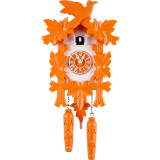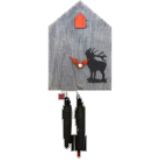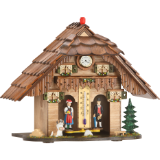Cuckoo clocks through the ages
The epitome of the Black Forest clock is the cuckoo clock. As already mentioned, the exact beginning of clock making in the Black Forest is not 100% certain. There is also some dispute as to when and where the first clock with a cuckoo mechanism was built. It can be assumed that a mechanism by which a cuckoo figure produces its unmistakable call by means of organ pipes and bellows was first developed in parallel in other figure automatons. It is known for certain that a clock with a cuckoo call was already in the collection of Elector August of Saxony in 1619.
Sources also indicate that by 1669 at the latest, the mechanism had become generally known, and the idea of using the cuckoo call as a sound signal in wall clocks quickly gained popularity. Whether Franz Anton Ketterer began building the first Black Forest cuckoo clocks in 1730, or Michael Dilger and Matthäus Hummel in 1742, or whether the beginning can be dated back even earlier, remains to be seen. What is certain is that the Black Forest cuckoo clock pioneers were responsible for the final breakthrough and international fame of the cuckoo clock.
However, the early cuckoo clocks were still very different from today's clocks. The striking mechanism with the cuckoo call was built into different forms of clocks, frame clocks or shield clocks.
The first cuckoo clock that comes close to today's models was the "Bahnhäusleuhr" (railroad house clock) designed around 1850, which was based on the design of a railroad guard's house. It was the result of a design competition held by the Baden Clockmaking School in Furtwangen. It was not long before the cuckoo had 'conquered' this shape of the clock case for itself, so to speak, and the final triumph of the cuckoo clock as we know it began. The original form of today's cuckoo clock was consistently developed from 1860 onwards, with elaborate carvings and pine cone weights, and gradually became a landmark of the Black Forest.




























